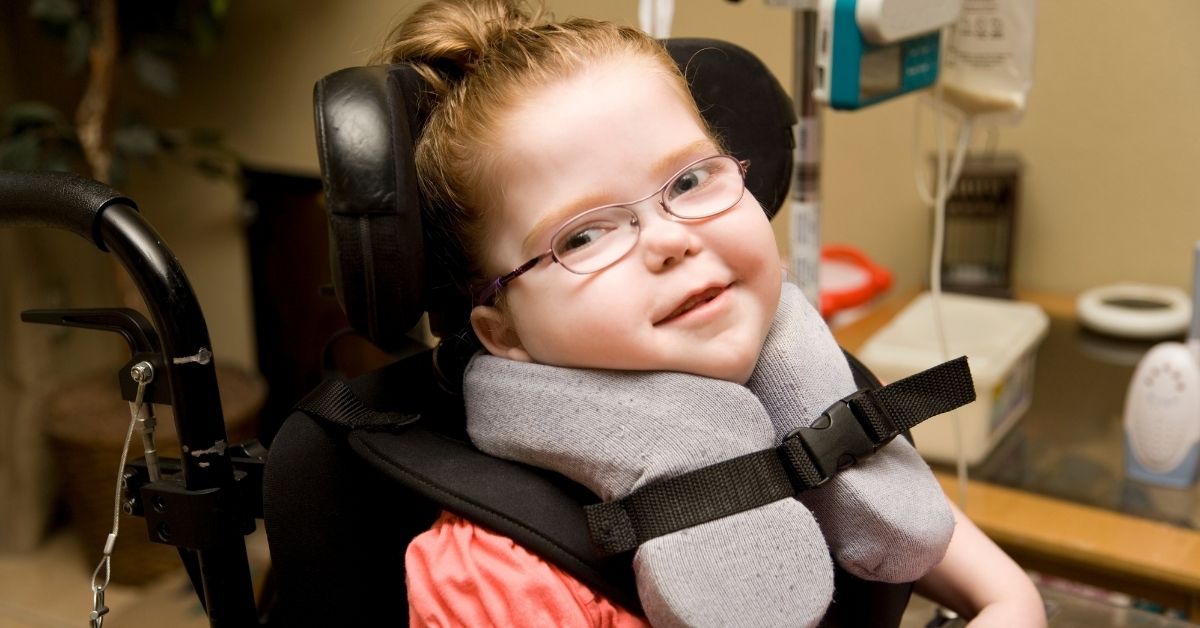
Authors: Jaclyn Tencer, MD; Sonika Agarwal, MBBS, MD
Children’s Hospital of Philadelphia
Reviewed: April 2021
SUMMARY
Periventricular Leukomalacia (PVL) is a brain abnormality that occurs following an injury to a specific region of the brain.
- Periventricular refers to an area of tissue near the center of the brain. This tissue is located near the fluid-filled ventricles in the brain.
- Leuko refers to the white matter of the brain. White matter is made up of pathways that transmit information across the brain and nervous system.
- Malacia means softening.
PVL is a softening and scarring of the white matter around the ventricles in the brain. It can happen if the brain is injured during development in the womb. It can also happen around time of birth, especially if a baby is born prematurely. Premature babies are at the highest risk for this condition.
In this central area of the brain, pathways transmit information between the brain and the spinal cord as well as from one part of the brain to another. Injury in this area causes neurologic symptoms.
Motor function is commonly affected in PVL. This can lead to:
- Muscle weakness
- Muscle spasticity (stiffness)
- Muscle tone abnormalities
JUMP TO
Disorder Overview
CAUSES
PVL can occur while a fetus is in the womb, during delivery, or shortly after birth.
Premature Babies and PVL
Premature babies are at the highest risk for this condition. The more premature the baby is, the higher the risk of PVL. Those born before 30 weeks into pregnancy are the most vulnerable. In premature babies, the brain is still developing. The pathways around the ventricles are very fragile and vulnerable to injury. Prematurity leads to extra stress on the baby’s brain when outside the womb.
Common Causes of PVL
The most common causes of PVL include:
- Decreased oxygen to the brain. Premature babies usually have breathing problems. They therefore have difficulty getting enough oxygen to the brain. The periventricular white matter is very sensitive to decreased blood flow or oxygen. This can lead to something called ischemia, or cell destruction from lack of oxygen.
- Intraventricular Hemorrhage (IVH). As a baby’s brain is developing, the blood vessels in the brain are extremely fragile. Premature babies are at increased risk of injury to these vessels. These vessels that supply the periventricular white matter with oxygen. Injury to them can result in bleeding in the area. The bleeding is often graded (Grade I, Grade II, Grade III, and Grade IV) in order of severity. Grade IV is the most severe bleeding. This bleeding can cause new injury, which can lead to PVL.
- Infection. Infection or inflammation can injure the tissue in this central area of the brain.
SIGNS AND SYMPTOMS
In PVL, injury to the brain tissue occurs before, during or shortly after birth. However, symptoms are often minimal in young infants. They are usually first noticed months or even years after birth. This is because the brain continues to develop over time as the baby grows and matures.
PVL affects pathways in the brain that control muscle movements and other important body functions. Therefore, babies with PVL are at risk of:
- Motor disorders, such as muscle spasticity (stiffness), weakness, and muscle tone abnormalities
- Coordination problems
- Vision and hearing impairments
- Delayed cognitive development and learning challenges
The specific area of the body involved (right arm, left leg, and so on) depends on the side and specific part of the brain injured.
PVL and Cerebral Palsy
Children with PVL are at risk for cerebral palsy (CP). PVL is the leading cause of CP in preterm infants. CP is a general term for conditions that include motor and cognitive symptoms. These symptoms can vary in severity. CP does not progress with time. However, its symptoms may change with age.

Varied Symptoms
PVL symptoms can vary widely from one child to the next. Some children with PVL may be completely asymptomatic. Some may have very mild symptoms and go undiagnosed. Yet others may have severe symptoms. Sometimes, imaging can show a small degree of PVL, yet there are no clinical symptoms.
However, most infants and children present with delays in movement and developmental milestones. Delays may become increasingly apparent over time. PVL can cause delays in:
- Head control
- Rolling over
- Sitting
- Crawling
- Standing
- Walking
- Speech
- Learning
Vision challenges, abnormal eye movements, and cognitive and behavioral conditions are also common.
DIAGNOSIS / LABORATORY INVESTIGATION
A diagnosis of PVL is confirmed through brain imaging. Brain imaging means taking pictures of the brain. Common imaging methods for PVL include:
Cranial ultrasound (US)
Magnetic Resonance Imaging (MRI)

TREATMENTS AND THERAPIES
There is no cure for PVL. Injury to that brain tissue cannot be reversed. However, the injury will not worsen with time. That is why PVL is considered a “static” condition.
Symptoms and Available Treatments
There are treatments that can help with the symptoms caused by PVL:
Spasticity
Medications and physical therapy can manage high tone or stiffness in muscles. For instance, injections of botulinum toxin can help loosen muscles. Medications such as muscle relaxants and paralytic agents are commonly used, as well. Learn more about spasticity.
Weakness
Cognitive, speech, language, or motor delays
Vision problems
Learning challenges
Multidisciplinary care
Together, these experts can help guide families with a plan for treatment. They can recommend therapies. They can provide long-term follow up. All of this can help a child achieve the best possible outcome. Their teams can help them lead a full life.
OUTLOOK
Variability in Outcomes
Outcomes vary widely depending on how severe the initial brain injury was. Some children have mild or no symptoms. They may not even be diagnosed until a later age. Others may have some mild weakness or stiffness in their arms or legs. They may require bracing or physical therapy, but function well otherwise. Still others are on the more severe end of the spectrum. They may have more impairments. They require more support for their activities of daily living.
Environment and Outcomes
The outcomes of PVL can be shaped by many things. Environment is a very important factor. It can affect the brain of a developing newborn. Several studies have shown that an enriched, stimulating environment can affect outcomes for a child. It can lead to better IQ, better language and learning skills, and more. Meanwhile a child who has limited exposures and supports may not fare as well.
An enriching environment can include:
- A good support system
- Human interaction
- Opportunities for reading and language development
Supportive care, therapies and special education programs can also go a long way. They can greatly improve the long-term outcomes of children with PVL.

Resources
ORGANIZATIONS/GROUPS
PVL Periventricular Leukomalacia
PVL Periventricular Leukomalacia, a private Facebook group, was started in 2007 to help support families whose child has been diagnosed with Periventricular Leukomalacia. You can join the community to get support and share your stories. Currently the group has over 4,000 members.
PUBLICATIONS
JCN: NICU Series — Prematurity and the Brain
Podcast from SAGE Neuroscience and Neurology/Journal of Child Neurology (JCN). In this podcast, Dr. Sonika Agarwal of Children’s Hospital of Philadelphia talks about prematurity and the brain.
Child Neurology Foundation (CNF) solicits resources from the community to be included on this webpage through an application process. CNF reserves the right to remove entities at any time if information is deemed inappropriate or inconsistent with the mission, vision, and values of CNF.
Research
ClincalTrials.gov for Periventricular Leukomalacia are clinical trials that are recruiting or will be recruiting. Updates are made daily, so you are encouraged to check back frequently.
ClinicalTrials.gov is a database of privately and publicly funded clinical studies conducted around the world. This is a resource provided by the U.S. National Library of Medicine (NLM), which is an institute within the National Institutes of Health (NIH). Listing a study does not mean it has been evaluated by the U.S. Federal Government. Please read the NLM disclaimer for details.
Before participating in a study, you are encouraged to talk to your health care provider and learn about the risks and potential benefits.
The information in the CNF Child Neurology Disorder Directory is not intended to provide diagnosis, treatment, or medical advice and should not be considered a substitute for advice from a healthcare professional. Content provided is for informational purposes only. CNF is not responsible for actions taken based on the information included on this webpage. Please consult with a physician or other healthcare professional regarding any medical or health related diagnosis or treatment options.
References
National Institute of Neurological Disorders and Stroke [Internet]. National Institutes of Heath [updated 2019 Mar 27; cited 2021 Apr 13]. Periventricular leukomalacia information page. Available from: https://www.ninds.nih.gov/Disorders/All-Disorders/Periventricular-Leukomalacia-Information-Page#disorders-r1
Genetic and Rare Diseases Information Center (GARD) – An NCATS program [Internet]. National Institutes of Health [cited 2021 Apr 13]. Periventricular leukomalacia. Available from: https://rarediseases.info.nih.gov/diseases/10285/periventricular-leukomalacia
